The Hybrid Solar Wind Energy Storage Market is estimated to be valued at USD 2.3 billion in 2025 and is projected to reach USD 5.9 billion by 2035, registering a compound annual growth rate (CAGR) of 9.8% over the forecast period. The hybrid solar wind energy storage market is projected to create an absolute dollar opportunity of USD 3.6 billion over the forecast period. This growth reflects a multiplier of 2.57x, supported by a strong CAGR of 9.8%, driven by the increasing adoption of renewable energy solutions, grid stability requirements, and government incentives for sustainable energy storage systems.
In the first five-year phase (2025 to 2030), the market is expected to reach approximately USD 3.6 billion, adding USD 1.3 billion, which accounts for 36.1% of the total incremental growth, fueled by advances in hybrid energy systems and energy storage technologies. The second phase (2030–2035) contributes USD 2.3 billion, representing 63.9% of incremental growth, signaling accelerated adoption as energy storage systems become more integrated with smart grids, renewable power plants, and decentralized energy networks.
Annual increments increase from USD 0.3 billion in early years to USD 0.5 billion by 2035, driven by technological improvements in hybrid storage systems, cost reductions, and regulatory support. Manufacturers focusing on scalable, high-efficiency storage solutions and seamless integration with solar and wind energy projects will capture the largest share of this USD 3.6 billion opportunity, particularly in regions focused on energy independence and grid modernization.
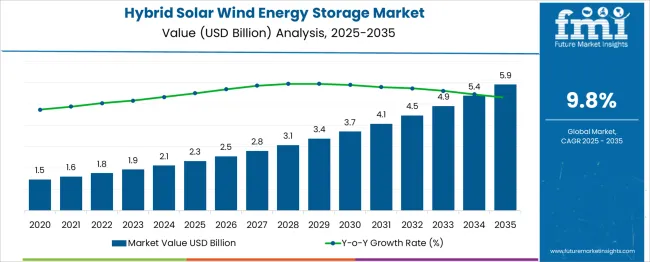
| Metric | Value |
|---|---|
| Hybrid Solar Wind Energy Storage Market Estimated Value in (2025 E) | USD 2.3 billion |
| Hybrid Solar Wind Energy Storage Market Forecast Value in (2035 F) | USD 5.9 billion |
| Forecast CAGR (2025 to 2035) | 9.8% |
The hybrid solar wind energy storage market is gaining traction due to accelerating global decarbonization targets, increasing energy reliability needs, and grid modernization efforts. Integration of solar and wind generation with advanced storage systems is reducing intermittency challenges and improving load balancing across distributed energy networks.
Supportive policy frameworks, including clean energy mandates and financial incentives for renewable infrastructure, are encouraging utilities and industries to adopt hybrid systems at scale. Advances in technology in battery storage, power electronics, and control systems are optimizing performance and enhancing the return on investment.
Moreover, the rising volatility in fossil fuel prices and growing concerns over energy security are further reinforcing the shift toward hybrid renewable models. The market outlook remains strong, driven by utility-scale deployments, industrial sustainability goals, and the need for resilient, decentralized energy solutions across both developed and emerging economies.
The hybrid solar wind energy storage market is segmented by product, end use, and geographic regions. The hybrid solar wind energy storage market is divided into Grid-connected and Standalone. In terms of end use, the hybrid solar wind energy storage market is classified into Utility/Industrial, Residential, and Commercial. Regionally, the hybrid solar wind energy storage industry is classified into North America, Latin America, Western Europe, Eastern Europe, Balkan & Baltic Countries, Russia & Belarus, Central Asia, East Asia, South Asia & Pacific, and the Middle East & Africa.
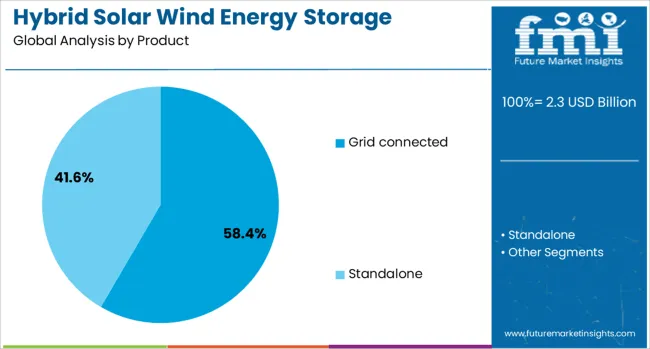
The grid connected segment is projected to account for 58.40% of the total market share in 2025, positioning it as the dominant product category in the hybrid solar wind energy storage market. This leadership is being driven by rising investments in grid infrastructure upgrades, coupled with the need for large-scale renewable integration to meet growing electricity demand.
Grid connected systems enable surplus power transmission, better grid stabilization, and frequency control, making them vital for utility operators managing renewable variability. Enhanced compatibility with smart grid technologies, combined with reduced curtailment losses, has further encouraged widespread deployment.
Additionally, grid support regulations and tariff-based incentives for feed-in mechanisms have solidified the grid connected segment’s prominence, especially in regions emphasizing low-carbon transition.
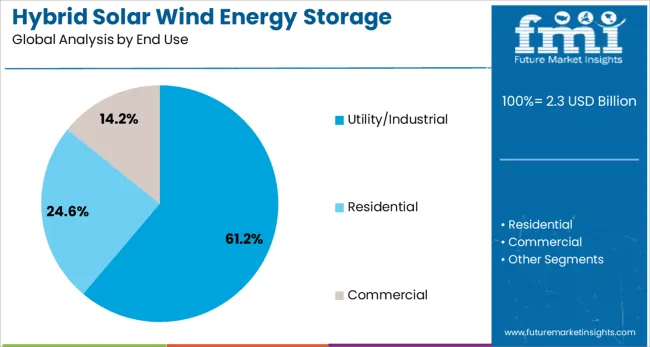
The utility/industrial end use segment is expected to capture 61.20% of the market share by 2025, making it the largest contributor in terms of application. This dominance is being attributed to the sector’s significant energy consumption, carbon reduction commitments, and investment capacity for large-scale renewable energy infrastructure.
Hybrid solar wind systems, coupled with storage, provide a reliable and sustainable power supply for industrial operations and utility providers facing stringent emission targets. The ability to reduce dependency on grid imports, enhance energy autonomy, and mitigate peak demand charges has made hybrid systems attractive for continuous operation environments.
Moreover, favorable public-private partnerships and green financing options are accelerating deployments across industrial parks, mining operations, and utility-scale renewable hubs.
The hybrid solar-wind energy storage market is expanding, driven by the increasing demand for reliable, off-grid renewable energy solutions. In 2024 and 2025, growth drivers include rising energy consumption and the need for more stable, efficient power sources. Opportunities exist in rural electrification and integrating energy storage systems with smart grids. Emerging trends include the development of hybrid energy systems for increased efficiency. However, challenges such as high installation costs, energy conversion inefficiencies, and regulatory barriers are limiting the market’s potential.
The primary growth driver is the rising global demand for reliable, clean energy solutions. In 2024 and 2025, hybrid solar-wind systems became increasingly popular for off-grid and remote areas where access to reliable power is limited. These systems provide a stable and sustainable energy source by combining solar and wind energy with storage solutions. As the need for continuous, efficient power increases, the adoption of hybrid energy systems is expected to rise, pushing the market’s growth trajectory.
Significant opportunities exist in rural electrification and the integration of hybrid systems with smart grids. In 2025, hybrid solar-wind energy storage systems were increasingly deployed to power remote and underserved communities, addressing energy access issues. Additionally, the integration of these systems with smart grids enabled better energy management, optimizing supply and demand. These advancements suggest that hybrid systems are not only crucial for energy access but are also key to modernizing energy distribution networks.
Emerging trends include the development of hybrid energy systems and advanced energy management solutions. In 2024, hybrid solar-wind systems gained popularity due to their ability to provide reliable energy generation from both solar and wind sources, reducing dependency on a single energy source. Energy management systems integrating AI and machine learning were also used to optimize performance, predict energy output, and ensure efficient storage. These trends indicate a growing shift towards more advanced, reliable, and optimized hybrid energy systems.
Key market restraints include high installation costs and energy conversion inefficiencies. In 2024 and 2025, the initial capital required to set up hybrid systems, including solar panels, wind turbines, and energy storage units, remained a significant barrier for many potential users. Additionally, energy conversion losses in hybrid systems, as well as challenges in balancing energy storage and supply, hindered overall efficiency. These constraints highlight the need for cost-effective solutions and improved energy conversion technologies to enhance system performance and market growth.
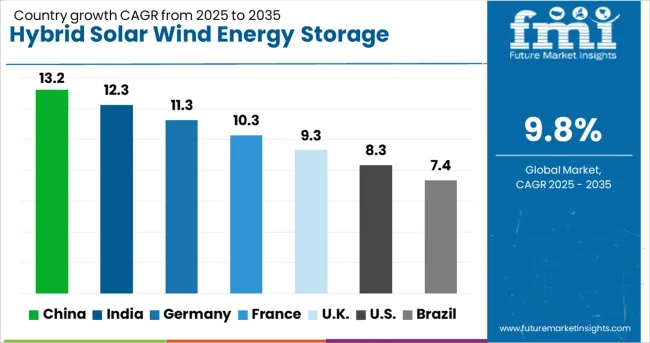
| Country | CAGR |
|---|---|
| China | 13.2% |
| India | 12.3% |
| Germany | 11.3% |
| France | 10.3% |
| UK | 9.3% |
| USA | 8.3% |
| Brazil | 7.4% |
The global hybrid solar wind energy storage market is projected to grow at 9.8% CAGR from 2025 to 2035. China leads with 13.2% CAGR, supported by large-scale investments in renewable energy infrastructure, energy storage solutions, and government incentives for hybrid systems. India follows at 12.3%, driven by the country’s push for sustainable energy solutions and expanding renewable energy capacity.
Germany records 11.3% CAGR, reflecting strong demand for integrated energy storage systems as part of the country’s renewable energy transition. The United Kingdom grows at 9.3%, while the United States posts 8.3%, reflecting steady growth in mature markets with a focus on enhancing energy resilience and integrating hybrid energy systems.
Asia-Pacific leads in market growth due to large-scale renewable projects, while Europe and North America focus on advanced energy storage technologies and regulatory support. This report includes insights on 40+ countries; the top markets are shown here for reference.
The hybrid solar wind energy storage market in China is forecasted to grow at 13.2% CAGR, driven by the country’s commitment to achieving carbon neutrality and accelerating renewable energy deployment. China is investing heavily in renewable energy systems that combine solar and wind power, paired with energy storage solutions to ensure stable power supply. The growing demand for grid stability in both urban and rural areas, along with government incentives, supports the rapid adoption of hybrid energy systems across the country.
The hybrid solar wind energy storage market in India is projected to grow at 12.3% CAGR, supported by the country’s renewable energy targets and rapid expansion of solar and wind energy capacity. India’s government initiatives, such as the National Action Plan on Climate Change, drive the integration of solar and wind power with advanced energy storage systems. Increasing demand for stable, uninterrupted power supply in both rural and industrial sectors contributes to the rising need for hybrid energy solutions.
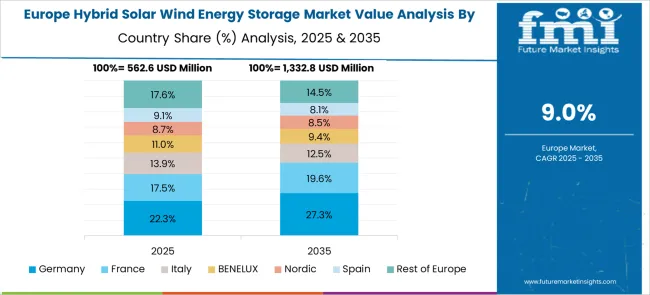
The hybrid solar wind energy storage market in Germany is expected to grow at 11.3% CAGR, fueled by the country’s ambitious renewable energy goals and commitment to reducing greenhouse gas emissions. Germany’s focus on integrating solar and wind power with energy storage systems to balance grid load and ensure energy security enhances market growth. The country’s strong regulatory frameworks, government subsidies, and incentives for renewable energy projects further promote the adoption of hybrid systems.
The hybrid solar wind energy storage market in the United Kingdom is projected to grow at 9.3% CAGR, supported by the country’s commitment to achieving net-zero carbon emissions by 2050. As part of the UK’s renewable energy transition, there is increasing demand for hybrid energy systems to ensure grid stability, energy security, and sustainability. The government’s support for clean energy projects, along with private sector investments in energy storage technologies, further stimulates market growth.
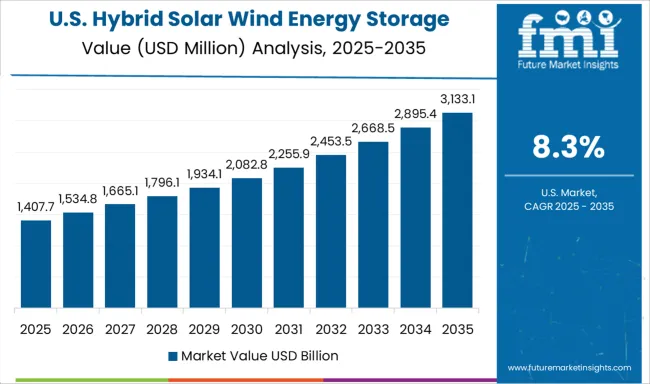
The hybrid solar wind energy storage market in the United States is projected to grow at 8.3% CAGR, reflecting steady demand driven by a focus on enhancing energy resilience and expanding renewable energy infrastructure. The USA government’s push for clean energy solutions and renewable energy integration, particularly in rural areas and the industrial sector, supports market growth. As states implement policies to accelerate the adoption of green technologies, hybrid solar-wind energy systems with advanced storage capabilities gain traction in energy markets.
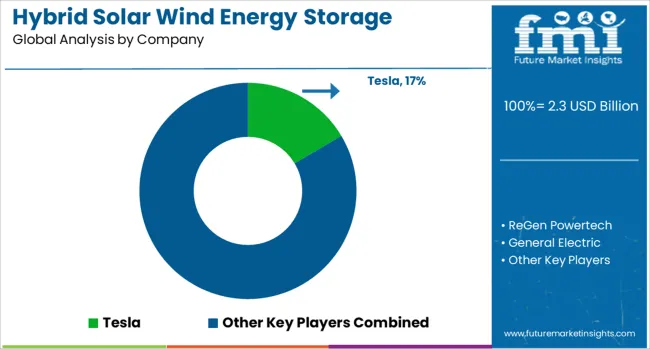
The hybrid solar wind energy storage market is dominated by Tesla, which secures its leadership through cutting-edge energy storage solutions and integrated renewable energy systems, combining solar and wind power with advanced battery storage technology. Tesla’s dominance is supported by its innovation in grid-scale energy storage and sustainable energy systems for both residential and industrial applications.
Key players such as General Electric, Siemens Gamesa, Vestas, and A123 Systems maintain significant market shares by offering hybrid energy solutions that combine wind turbine technology, solar panels, and high-efficiency storage systems for uninterrupted power supply and energy optimization. These companies focus on scalability, cost reduction, and seamless integration with existing power grids.
Emerging players like ReGen Powertech, Suzlon, Goldwind, Vattenfall AB, and Polar Power are expanding their market presence by providing customized hybrid systems for off-grid applications, rural electrification, and energy independence. Their strategies focus on improving storage efficiency, leveraging advanced control systems, and enhancing renewable energy production to meet the growing global demand for sustainable energy solutions.
Market growth is driven by increasing investments in renewable energy infrastructure, government incentives, and the rising need for energy security and storage solutions. Technological advancements in hybrid systems, enhanced battery storage, and integration with smart grid technologies are expected to influence competitive dynamics and drive further adoption globally.
| Item | Value |
|---|---|
| Quantitative Units | USD 2.3 Billion |
| Product | Grid connected and Standalone |
| End Use | Utility/Industrial, Residential, and Commercial |
| Regions Covered | North America, Europe, Asia-Pacific, Latin America, Middle East & Africa |
| Country Covered | United States, Canada, Germany, France, United Kingdom, China, Japan, India, Brazil, South Africa |
| Key Companies Profiled | Tesla, ReGen Powertech, General Electric, Vestas, Siemens Gamesa, Vattenfall AB, Goldwind, Suzlon, Alpha Windmills, Blue Pacific Solar, Zenith Solar, Unitron Energy, Polar Power, Grupo Dragon, and A123 Systems |
| Additional Attributes | Dollar sales by energy storage type and system configuration, demand dynamics across residential, commercial, and industrial sectors, regional trends in hybrid energy adoption, innovation in storage technologies and integration, impact of regulatory policies on renewable energy, and emerging use cases in off-grid and microgrid applications. |
The global hybrid solar wind energy storage market is estimated to be valued at USD 2.3 billion in 2025.
The market size for the hybrid solar wind energy storage market is projected to reach USD 5.9 billion by 2035.
The hybrid solar wind energy storage market is expected to grow at a 9.8% CAGR between 2025 and 2035.
The key product types in hybrid solar wind energy storage market are grid connected and standalone.
In terms of end use, utility/industrial segment to command 61.2% share in the hybrid solar wind energy storage market in 2025.






Our Research Products

The "Full Research Suite" delivers actionable market intel, deep dives on markets or technologies, so clients act faster, cut risk, and unlock growth.

The Leaderboard benchmarks and ranks top vendors, classifying them as Established Leaders, Leading Challengers, or Disruptors & Challengers.

Locates where complements amplify value and substitutes erode it, forecasting net impact by horizon

We deliver granular, decision-grade intel: market sizing, 5-year forecasts, pricing, adoption, usage, revenue, and operational KPIs—plus competitor tracking, regulation, and value chains—across 60 countries broadly.

Spot the shifts before they hit your P&L. We track inflection points, adoption curves, pricing moves, and ecosystem plays to show where demand is heading, why it is changing, and what to do next across high-growth markets and disruptive tech

Real-time reads of user behavior. We track shifting priorities, perceptions of today’s and next-gen services, and provider experience, then pace how fast tech moves from trial to adoption, blending buyer, consumer, and channel inputs with social signals (#WhySwitch, #UX).

Partner with our analyst team to build a custom report designed around your business priorities. From analysing market trends to assessing competitors or crafting bespoke datasets, we tailor insights to your needs.
Supplier Intelligence
Discovery & Profiling
Capacity & Footprint
Performance & Risk
Compliance & Governance
Commercial Readiness
Who Supplies Whom
Scorecards & Shortlists
Playbooks & Docs
Category Intelligence
Definition & Scope
Demand & Use Cases
Cost Drivers
Market Structure
Supply Chain Map
Trade & Policy
Operating Norms
Deliverables
Buyer Intelligence
Account Basics
Spend & Scope
Procurement Model
Vendor Requirements
Terms & Policies
Entry Strategy
Pain Points & Triggers
Outputs
Pricing Analysis
Benchmarks
Trends
Should-Cost
Indexation
Landed Cost
Commercial Terms
Deliverables
Brand Analysis
Positioning & Value Prop
Share & Presence
Customer Evidence
Go-to-Market
Digital & Reputation
Compliance & Trust
KPIs & Gaps
Outputs
Full Research Suite comprises of:
Market outlook & trends analysis
Interviews & case studies
Strategic recommendations
Vendor profiles & capabilities analysis
5-year forecasts
8 regions and 60+ country-level data splits
Market segment data splits
12 months of continuous data updates
DELIVERED AS:
PDF EXCEL ONLINE
Hybrid Reactive Power and Harmonic Compensation Device Market Size and Share Forecast Outlook 2025 to 2035
Hybrid Vision Sensor Chips Market Size and Share Forecast Outlook 2025 to 2035
Hybrid Printing Market Forecast Outlook 2025 to 2035
Hybrid Boat Market Size and Share Forecast Outlook 2025 to 2035
Hybrid Metal-Paper Seamers Market Size and Share Forecast Outlook 2025 to 2035
Hybrid Sealing-Cut Machines Market Analysis - Size and Share Forecast Outlook 2025 to 2035
Hybrid Powertrain Market Size and Share Forecast Outlook 2025 to 2035
Hybrid Additive Manufacturing Machines Market Size and Share Forecast Outlook 2025 to 2035
Hybrid Integration Platform Market Size and Share Forecast Outlook 2025 to 2035
Hybrid Marine Gensets Market Size and Share Forecast Outlook 2025 to 2035
Hybrid Meat Products Market Size and Share Forecast Outlook 2025 to 2035
Hybrid Generator Sets Market Size and Share Forecast Outlook 2025 to 2035
Hybrid Switchgear Market Size and Share Forecast Outlook 2025 to 2035
Hybrid Rice Seeds Market Size and Share Forecast Outlook 2025 to 2035
Hybrid Memory Cube Market Size and Share Forecast Outlook 2025 to 2035
Hybrid Aircraft Market Size and Share Forecast Outlook 2025 to 2035
Hybrid Cutters Market Analysis Size and Share Forecast Outlook 2025 to 2035
Hybrid Fabrics Market Size and Share Forecast Outlook 2025 to 2035
Hybrid Train Market Analysis - Size, Share, and Forecast Outlook 2025 to 2035
Hybrid Drivetrain Market Size and Share Forecast Outlook 2025 to 2035

Thank you!
You will receive an email from our Business Development Manager. Please be sure to check your SPAM/JUNK folder too.
Chat With
MaRIA